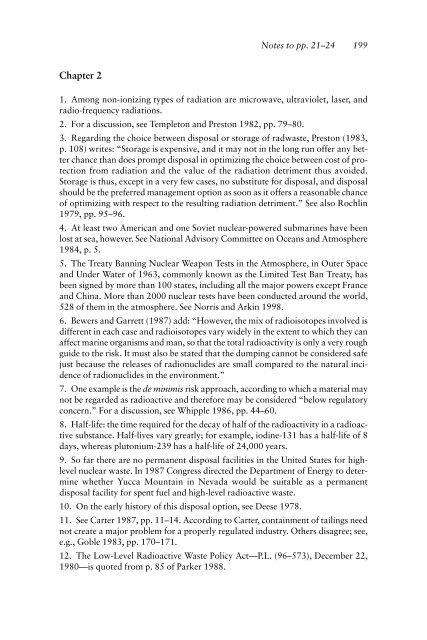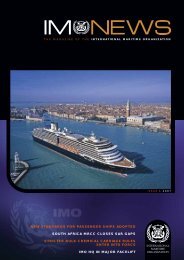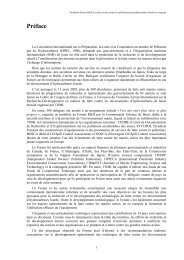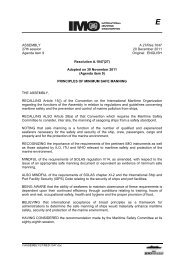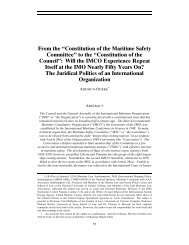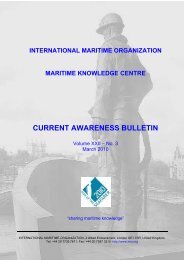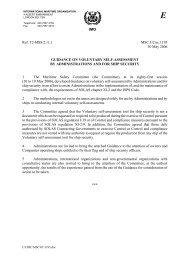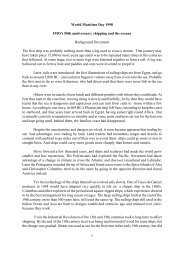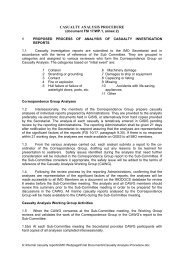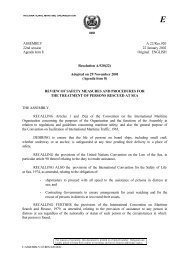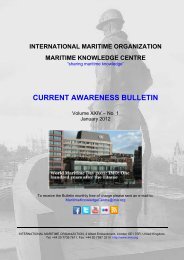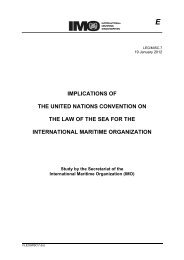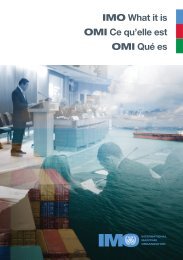Radioactive Waste Disposal at Sea: Public Ideas ... - IMO
Radioactive Waste Disposal at Sea: Public Ideas ... - IMO
Radioactive Waste Disposal at Sea: Public Ideas ... - IMO
Create successful ePaper yourself
Turn your PDF publications into a flip-book with our unique Google optimized e-Paper software.
Chapter 2<br />
Notes to pp. 21–24 199<br />
1. Among non-ionizing types of radi<strong>at</strong>ion are microwave, ultraviolet, laser, and<br />
radio-frequency radi<strong>at</strong>ions.<br />
2. For a discussion, see Templeton and Preston 1982, pp. 79–80.<br />
3. Regarding the choice between disposal or storage of radwaste, Preston (1983,<br />
p. 108) writes: “Storage is expensive, and it may not in the long run offer any better<br />
chance than does prompt disposal in optimizing the choice between cost of protection<br />
from radi<strong>at</strong>ion and the value of the radi<strong>at</strong>ion detriment thus avoided.<br />
Storage is thus, except in a very few cases, no substitute for disposal, and disposal<br />
should be the preferred management option as soon as it offers a reasonable chance<br />
of optimizing with respect to the resulting radi<strong>at</strong>ion detriment.” See also Rochlin<br />
1979, pp. 95–96.<br />
4. At least two American and one Soviet nuclear-powered submarines have been<br />
lost <strong>at</strong> sea, however. See N<strong>at</strong>ional Advisory Committee on Oceans and Atmosphere<br />
1984, p. 5.<br />
5. The Tre<strong>at</strong>y Banning Nuclear Weapon Tests in the Atmosphere, in Outer Space<br />
and Under W<strong>at</strong>er of 1963, commonly known as the Limited Test Ban Tre<strong>at</strong>y, has<br />
been signed by more than 100 st<strong>at</strong>es, including all the major powers except France<br />
and China. More than 2000 nuclear tests have been conducted around the world,<br />
528 of them in the <strong>at</strong>mosphere. See Norris and Arkin 1998.<br />
6. Bewers and Garrett (1987) add: “However, the mix of radioisotopes involved is<br />
different in each case and radioisotopes vary widely in the extent to which they can<br />
affect marine organisms and man, so th<strong>at</strong> the total radioactivity is only a very rough<br />
guide to the risk. It must also be st<strong>at</strong>ed th<strong>at</strong> the dumping cannot be considered safe<br />
just because the releases of radionuclides are small compared to the n<strong>at</strong>ural incidence<br />
of radionuclides in the environment.”<br />
7. One example is the de minimis risk approach, according to which a m<strong>at</strong>erial may<br />
not be regarded as radioactive and therefore may be considered “below regul<strong>at</strong>ory<br />
concern.” For a discussion, see Whipple 1986, pp. 44–60.<br />
8. Half-life: the time required for the decay of half of the radioactivity in a radioactive<br />
substance. Half-lives vary gre<strong>at</strong>ly; for example, iodine-131 has a half-life of 8<br />
days, whereas plutonium-239 has a half-life of 24,000 years.<br />
9. So far there are no permanent disposal facilities in the United St<strong>at</strong>es for highlevel<br />
nuclear waste. In 1987 Congress directed the Department of Energy to determine<br />
whether Yucca Mountain in Nevada would be suitable as a permanent<br />
disposal facility for spent fuel and high-level radioactive waste.<br />
10. On the early history of this disposal option, see Deese 1978.<br />
11. See Carter 1987, pp. 11–14. According to Carter, containment of tailings need<br />
not cre<strong>at</strong>e a major problem for a properly regul<strong>at</strong>ed industry. Others disagree; see,<br />
e.g., Goble 1983, pp. 170–171.<br />
12. The Low-Level <strong>Radioactive</strong> <strong>Waste</strong> Policy Act—P.L. (96–573), December 22,<br />
1980—is quoted from p. 85 of Parker 1988.


